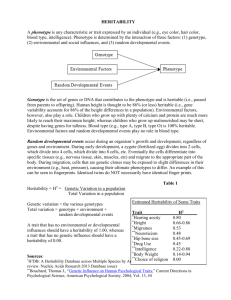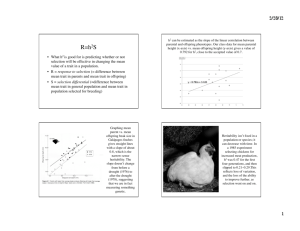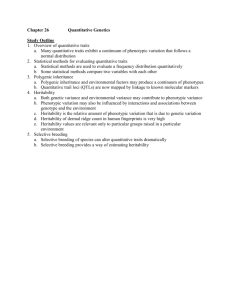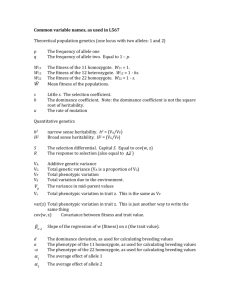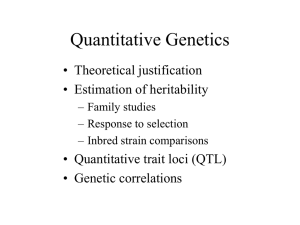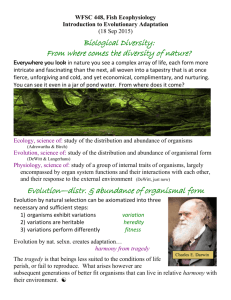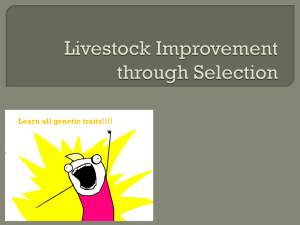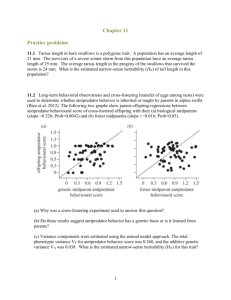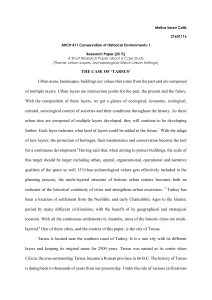Some Further Notes on Quantitative Genetics
advertisement
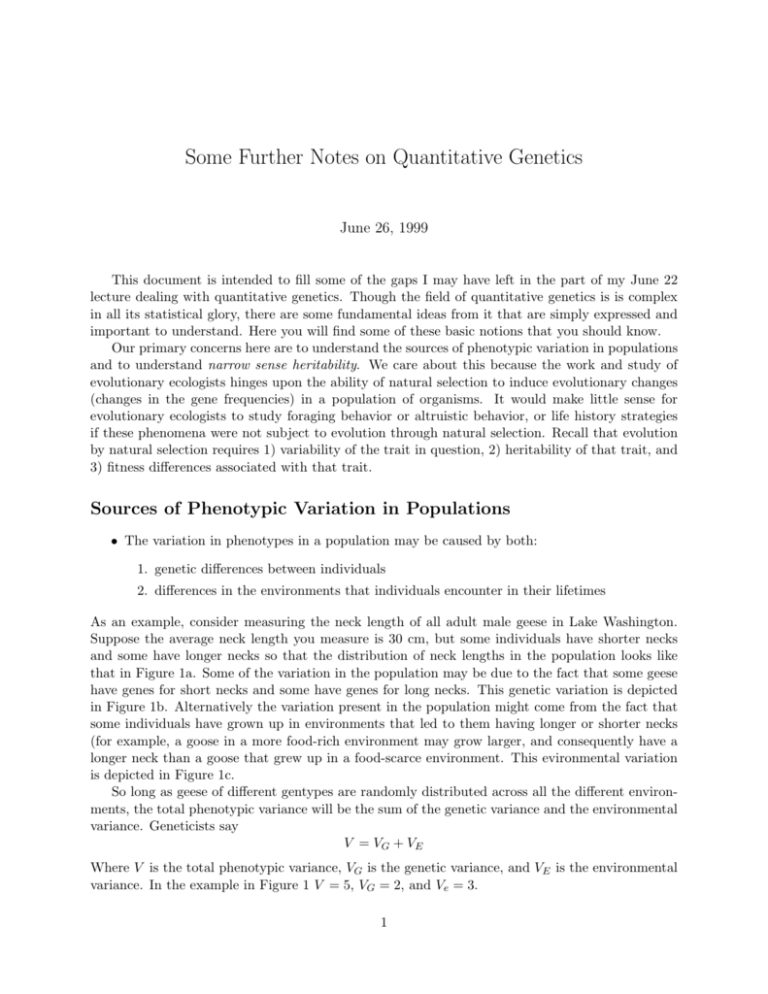
Some Further Notes on Quantitative Genetics June 26, 1999 This document is intended to fill some of the gaps I may have left in the part of my June 22 lecture dealing with quantitative genetics. Though the field of quantitative genetics is is complex in all its statistical glory, there are some fundamental ideas from it that are simply expressed and important to understand. Here you will find some of these basic notions that you should know. Our primary concerns here are to understand the sources of phenotypic variation in populations and to understand narrow sense heritability. We care about this because the work and study of evolutionary ecologists hinges upon the ability of natural selection to induce evolutionary changes (changes in the gene frequencies) in a population of organisms. It would make little sense for evolutionary ecologists to study foraging behavior or altruistic behavior, or life history strategies if these phenomena were not subject to evolution through natural selection. Recall that evolution by natural selection requires 1) variability of the trait in question, 2) heritability of that trait, and 3) fitness differences associated with that trait. Sources of Phenotypic Variation in Populations • The variation in phenotypes in a population may be caused by both: 1. genetic differences between individuals 2. differences in the environments that individuals encounter in their lifetimes As an example, consider measuring the neck length of all adult male geese in Lake Washington. Suppose the average neck length you measure is 30 cm, but some individuals have shorter necks and some have longer necks so that the distribution of neck lengths in the population looks like that in Figure 1a. Some of the variation in the population may be due to the fact that some geese have genes for short necks and some have genes for long necks. This genetic variation is depicted in Figure 1b. Alternatively the variation present in the population might come from the fact that some individuals have grown up in environments that led to them having longer or shorter necks (for example, a goose in a more food-rich environment may grow larger, and consequently have a longer neck than a goose that grew up in a food-scarce environment. This evironmental variation is depicted in Figure 1c. So long as geese of different gentypes are randomly distributed across all the different environments, the total phenotypic variance will be the sum of the genetic variance and the environmental variance. Geneticists say V = VG + VE Where V is the total phenotypic variance, VG is the genetic variance, and VE is the environmental variance. In the example in Figure 1 V = 5, VG = 2, and Ve = 3. 1 Total Phenotypic Variation in Neck Length Phenotypic Variation of all the Genotypes Grown in a Single Environment Phenotypic Variation of A Single Genotype Grown in all the different environments + = a b c Figure 1: (a) Hypothetical distribution of neck lengths in adult male geese in Lake Washington. (b) The distribution of neck lengths you would find if you raised all the different goose gentypes in a single environment. (c) The distribution of neck lengths you would find if you raised clones of any one goose in all the different environments available in Lake Washington. The full story is often more complex than that. One of the simplest complications occurs when there is an association between genotypes and environment types. For example geese that have genes for longer necks may then also have access to more food-rich environments (perhaps they can reach deeper underwater to eat aquatic plants). In this case, variation in genes in the population and the variation available in the environment would not be simply additive and the corresponding total phenotypic variation in the population would be greater than just the sum of VG and VE . The increase is accounted for by the covariance between genotypes and environments: V = VG + VE + 2CovG,E The covariance between genoytpes and environments CovG,E measures the strength of association between different genotypes and different environments. If geese with different genotypes are dispersed randomly across the environmental types CovG,E = 0, however, if geese with “long neck genes” are more likely found in environments that allow the growth of longer necks CovG,E will be positive. (CovG,E will be negative if geese with “long neck genes” tend to remain in environments that tend to stunt neck growth.) Environmental variation presents considerable problems for researchers trying to estimate how much variation in populations is due to heritable, genetic components. This is both because environments are heterogenous in space, and also in time; offspring do not always encounter the same environmental quality or variation as their parents. Understanding Heritability It is not difficult to go to a population and observe variability in a trait, but it is more difficult to know how much of the variability in that trait is heritable—this is where estimation methods from the field of quantitative genetics are useful. We saw in lecture some estimates, based on quantitative genetics methods for narrow-sense heritabilities for several different types of traits. These are reproduced in Table 1. The theory behind estimating narrow-sense heritability (also called h2 , or simply “heritability”) is quite beyond the purview of Biology 472, however being able to interpret those heritabilities is important for any ecologist. In other words, “What would it mean that h2 for a trait expressed by individuals in a population is 0.3?” 2 Table 1: Heritability estimates for different types of traits in populations of wild animals. Each estimate is an average over n studies which estimated heritability in some animal. The SE refers to the standard error over the different studies. [Source: Mousseau & Roff (1987) as it appears in Stearns (1992). ] n Mean Heritability S.E. Life History 341 0.262 0.012 Physiology 104 0.330 0.027 Behavior 105 0.302 0.023 Morphology 570 0.461 0.004 One can interpret narrow-sense heritability as the capacity of a population to respond to selection on a trait. It can also be interpreted as the variance of breeding values in the population, and as the proportion of the genetic variation in the population attributable to what is called “additive genetic variance.” Those last two ways of thinking about heritability however, are neither as intuitively pleasing nor directly understandable as the first interpretation. We will focus on the first interpretation here. Heritability as a capacity for response to selection Let us go back to the example used in class; we will consider the continuously distributed trait of tarsus length in grasshoppers. We will assume that the distribution of tarsus lengths in the population follows a bell-shaped curve as in Figure 2. This is, in fact a normal probability density curve with mean 4 mm and variance of .375. As you can see, most of the individuals in this population have tarsus lengths between 3 and 5 mm. Note that the probability that an individual in the population has a tarsus length between say Xmm and Y mm is the area under the curve between X and Y . Now, let us imagine that we can decide which of these grasshoppers will reproduce and which will not, and suppose that we decide that only those grasshoppers possessing tarsi longer than 4.75 mm will reproduce. So, we set aside all the grasshoppers with tarsi longer than 4.75 mm. If we then measured the average length of tarsus amongst the grasshoppers we set aside, we would find that it is greater than 4 mm—it obviously must be greater than the mean in the whole population. In fact, doing a little math, one can show that the mean tarsus length in the selected group of grasshoppers would be 5.05 mm. The effect of this selection can be described in terms of the difference in mean tarsus length before and after selection. This is called the selection differential. In this case the selection differential is 5.05mm − 4mm = 1.05mm. And finally, we ask what the offspring of these selected grasshoppers will look like. This is where heritability comes into play. Clearly if tarsus length is not a heritable trait, then there is no reason that the offspring of our selected group of hoppers should have mean tarsus length any different than 4 mm. But, if tarsus length is a heritable trait, then the offspring of the selected hoppers should have longer tarsi than the rest of the population. In fact, narrow-sense heritability (h2 ) gives us a simple relationship between the population mean, µ of a trait like tarsus length and the mean of such a trait in the offspring of a group of individuals selected from the population. If the group selected from the population has mean trait value µs (in our hopper case µs = 5.05), then the offspring resulting in random mating among that selected group will have mean trait value 3 2 3 5 4 6mm Figure 2: The distribution of tarsus lengths in a grasshopper population. The mean is 4 mm and the lengths are normally distributed with a variance of 0.375. µo , determined by the heritability of the trait: µo = µ + h2 (µs − µ). Another way of expressing this is to say that ∆µ, the change relative to the original population in the mean trait value (i.e. tarsus length) among the offspring of a selected group is the product of the narrow-sense heritability of the trait, and the selection differential, S. ∆µ = h2 S Putting our actual numbers back in there for our group of hoppers selected for tarsus lengths greater than 4.75 mm, if we knew that the heritability for tarsus length was, say, h2 = 0.3, then we would predict that the offspring of the selected group would have mean tarsus length of 4.315 = 4 + (0.3)(5.05 − 4). It may now be helpful to go back to Table 1 and review the heritability estimates listed there and imagine do some “selection experiments” in your head to make sure you understand how narrow sense heritability relates to a population’s capacity to respond to selection. Bibliography • Mousseau, T. A. and Roff, D. A. (1987). Natural selection and the heritability of fitness components, Heredity 59: 181–197. • Stearns, S. C. (1992). The Evolution of Life Histories, Oxford University Press, Oxford. 4

